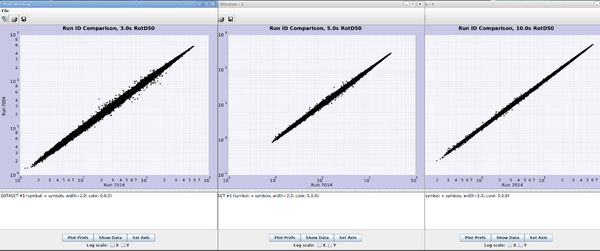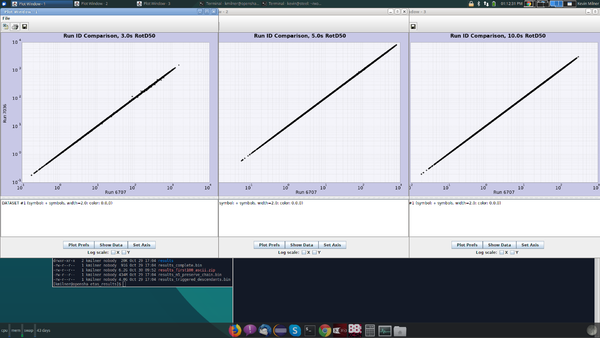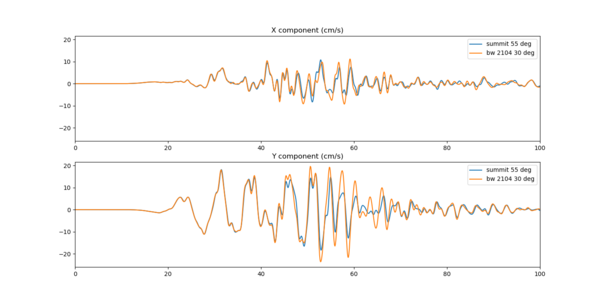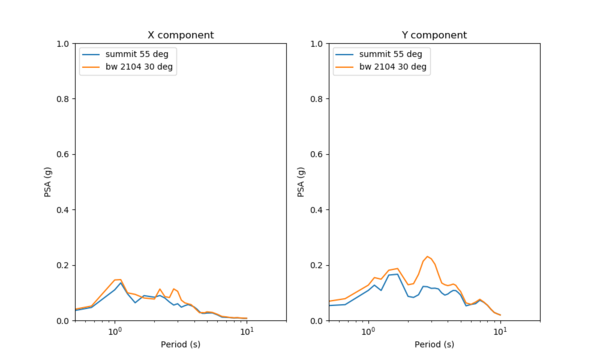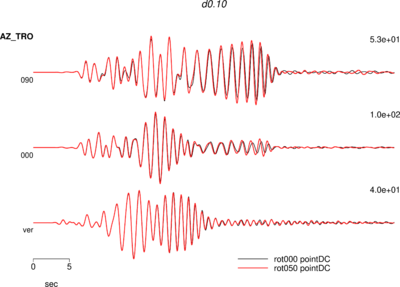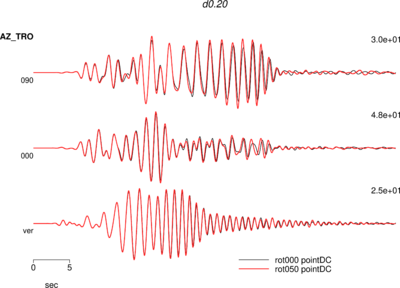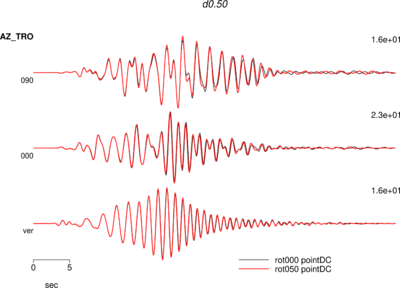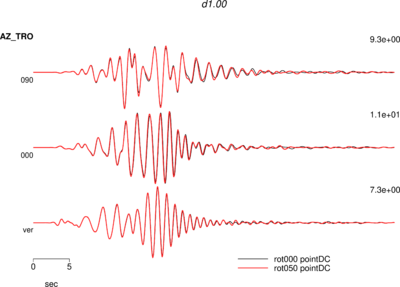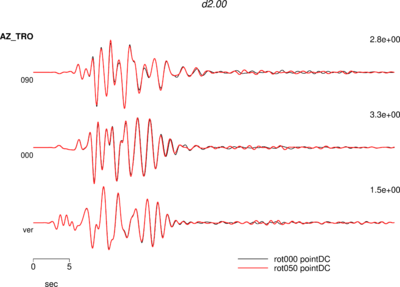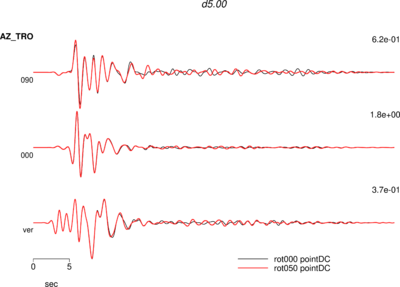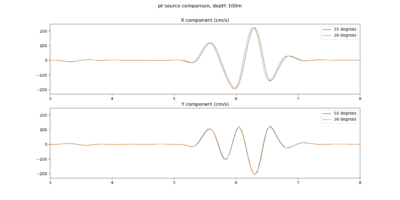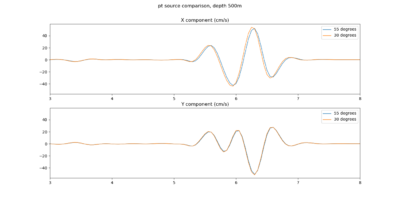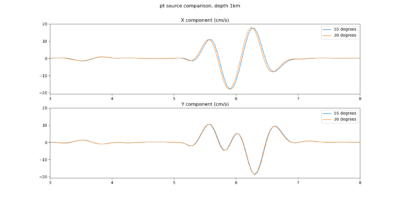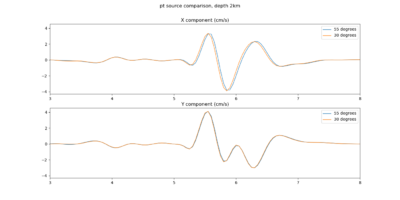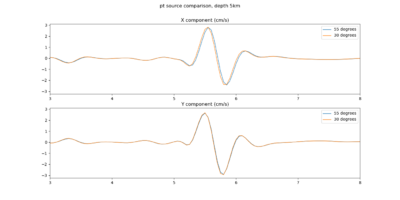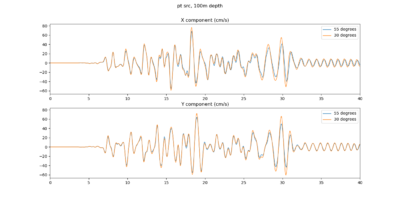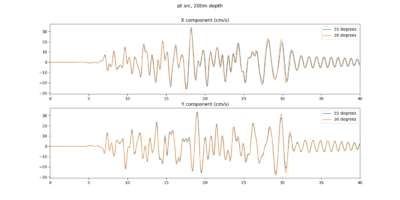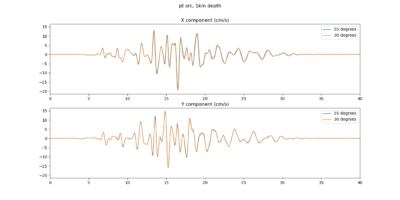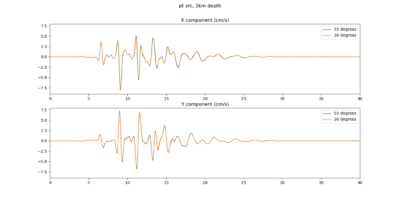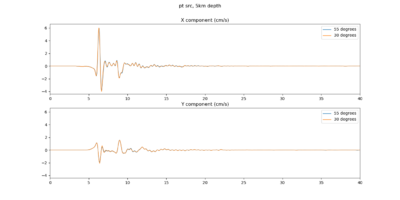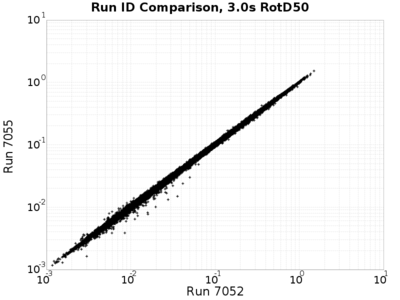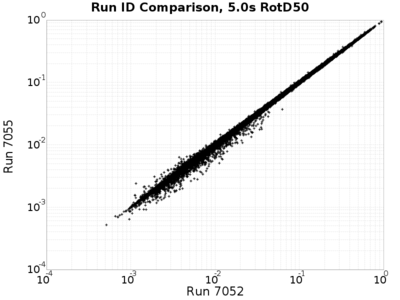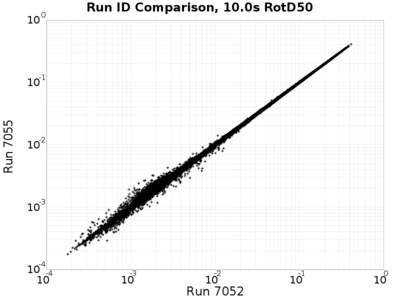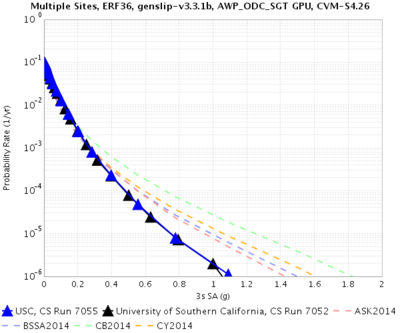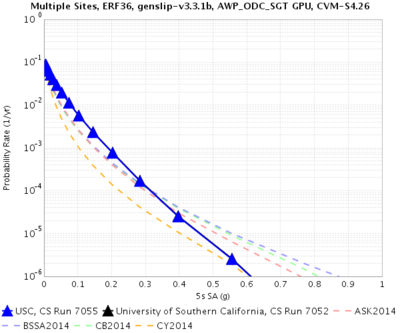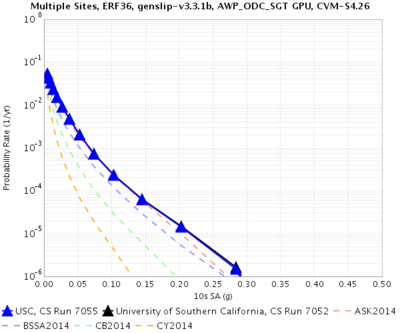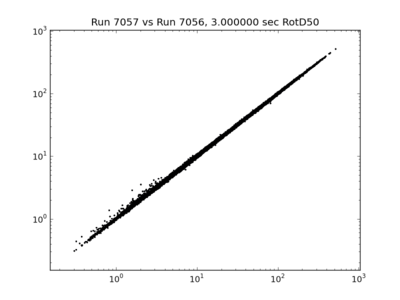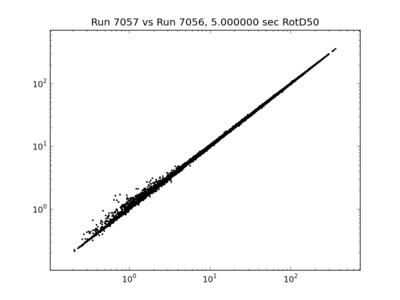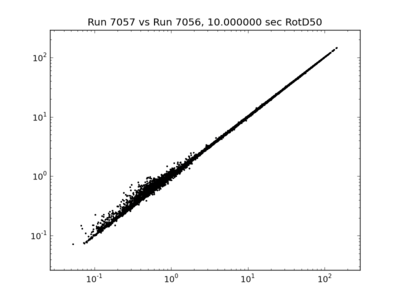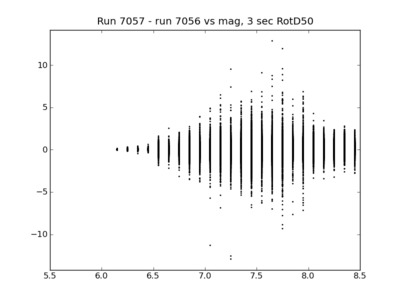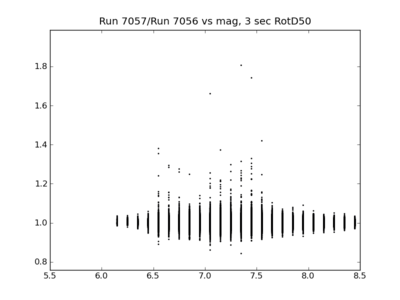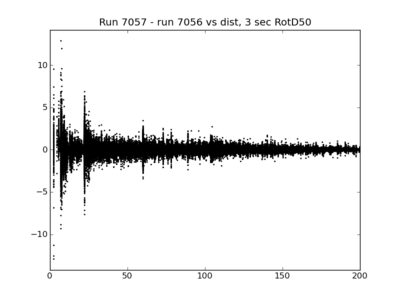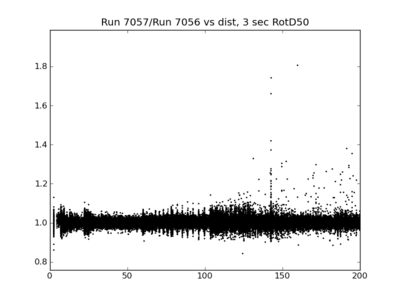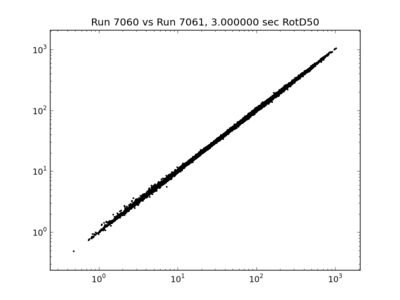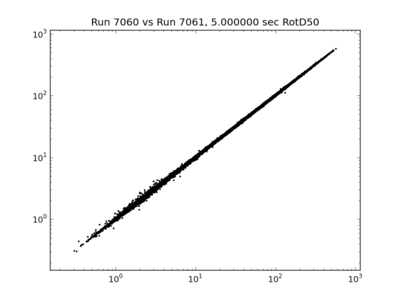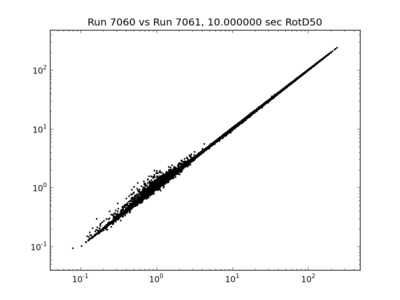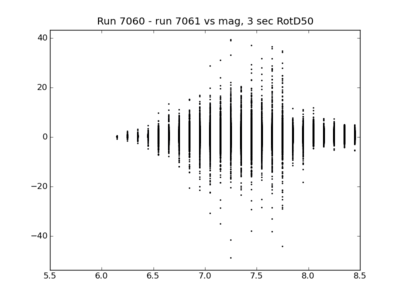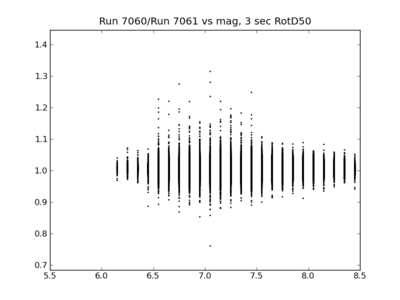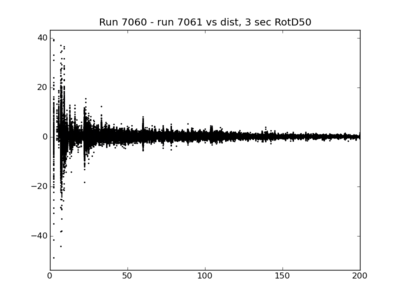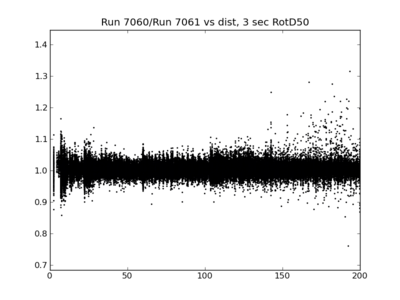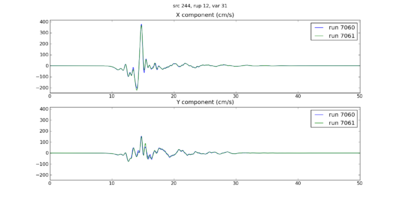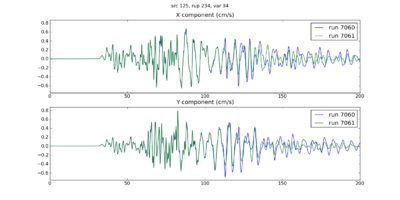CyberShake volume rotation
This page documents the differences we see in results when using volumes with different rotation angles, and the investigation of these differences.
Contents
Problem description
When attempting to replicate on Summit results for site USC using ERF 51 (an RSQSim-based ERF) originally obtained on Blue Waters, we ran into some difficulty.
The plot below shows a comparison of RotD values obtained on Summit (Run ID 7054) vs on Blue Waters (Run ID 7014). As you can see, there is a general trend but more scatter than anticipated; the two results should match almost exactly.
As a point of comparison, here are the same plots for the USC ERF 36 verification runs:
In particular, we identified source 684, rupture 323 as an event to investigate further. At a frequency of 3 seconds, the values obtained on Blue Waters were almost twice as big as those on Summit, 0.23 cm/s2 vs 0.12 cm/s2.
Below are plots comparing the seismograms and the geometric mean PSA values for these events on the two systems. The seismograms start to diverge after about 45 sec, and the geometric mean PSA values show the largest difference at about 3 sec.
Rotation angle
After running a series of tests, we identified that the difference seems to be related to the rotation angle: the smaller values are produced when running with a rotation angle of -55 degrees (what we have used in the past for southern California sites), and the larger values with a rotation of -30 degrees. Neither the site nor this source are near the volume boundaries.
Study 18.8 vs Study 17.3 comparison
Below are Rotd comparison plots for sites s845 and s835, hard rock sites which were included in both studies.
1D test, RWG
Rob Graves ran a 1D test in which seismograms were computed about 16 km from the source for rotation angles of 0 and -50 degrees. Below are plots comparing the three components at a variety of depths.
| depth | seismograms |
|---|---|
| 100m | |
| 200m | |
| 500m | |
| 1km | |
| 2km | |
| 5km |
1D test, AWP
We configured a similar test (point source, variety of depths, about 16 km from site) using the AWP SGT code and the Hadley-Kanamori 1D model. We see small differences with this code as well.
| depth | seismograms |
|---|---|
| 100m | |
| 200m | |
| 500m | |
| 1km | |
| 2km | |
| 5km |
1D test, AWP, Mojave 1D model
We repeated the above test using the BBP Mojave 1D model, the same model Rob used for his tests, and got much more similar results to Rob.
| depth | seismograms |
|---|---|
| 100m | |
| 200m | |
| 500m | |
| 1km | |
| 2km | |
| 5km |
ERF 36 (UCERF2, 200m spacing) test
We ran site USC using CVM-S4.26.M01 with -30 degree rotation, and compared the results to the 'standard' Southern California rotation of -55 degrees.
Overall, the differences get smaller as the ground motions get larger, and the hazard curves are visually identical, suggesting that the rotation angle has a negligible effect on hazard for UCERF2 simulations.
| 3 sec | 5 sec | 10 sec | |
|---|---|---|---|
| RotD comparisons | |||
| Hazard curves |
Note that the dropoff off the black curve in the 3 sec plot after 1 g is due to the fact that the black and blue curves are sampled at different X-values.
ERF 36 1D test
We repeated the above test, but using the UCVM built-in SCEC 1D velocity model. These results show slightly less scatter than the 3D results, but it's more asymmetric. Note that run 7056 (the X-axis) was done with a volume rotated -55 degrees, and 7057 with -30 degrees.
| 3 sec | 5 sec | 10 sec | |
|---|---|---|---|
| RotD comparisons |
Here are statistics on the above runs:
| Differences (run 7057 - run 7056) of linear values (cm/s2) |
Differences of natural log values | Linear Ratios (run 7057/run 7056) | |
|---|---|---|---|
| Min | -12.929062 | -0.170983 | 0.842836 |
| Max | 12.866089 | 0.591074 | 1.805926 |
| Mean | 0.031936 | 0.001222 | 1.001283 |
| Std Dev | 0.363081 | 0.010961 | 0.011117 |
| Mean Abs | 0.193350 | 0.007560 |
We also created plots comparing the difference and ratios to shortest site-rupture distance and magnitude.
| Difference (cm/s2) | Ratio | |
|---|---|---|
| Magnitude | ||
| Distance |
ERF 36 Mojave 1D test
We repeated the above test again, but this time using the Mojave 1D model from the BBP, which has much lower near-surface velocities than the Hadley-Kanamori 1D model. Run 7060 was done with -30 degrees, and run 7061 with -55 degrees.
| 3 sec | 5 sec | 10 sec | |
|---|---|---|---|
| RotD comparisons |
Here are statistics on the above runs:
| Differences (run 7057 - run 7056) of linear values (cm/s2) |
Differences of natural log values | Linear Ratios (run 7057/run 7056) | |
|---|---|---|---|
| Min | -48.872131 | -0.27381 | 0.760476 |
| Max | 39.215027 | 0.273622 | 1.314718 |
| Mean | 0.223698 | 0.004606 | 1.004685 |
| Std Dev | 1.021811 | 0.011675 | 0.011753 |
| Mean Abs | 0.483368 | 0.009155 |
Here are plots comparing the difference and ratios to shortest site-rupture distance and magnitude.
| Difference (cm/s2) | Ratio | |
|---|---|---|
| Magnitude | ||
| Distance |
We extracted seismograms for the biggest difference (48.9 cm/s2, for source 244, rupture 12, rup var 31) and biggest ratio (1.3, for source 125, rupture 234, rup var 34), below. The Garlock fault is about 50 km from the 30 degree volume boundary, and 40 km from the 55 degree volume boundary.
| Biggest difference (M7.25 Puente Hills) | Biggest ratio (M7.05 Garlock) |
|---|---|
